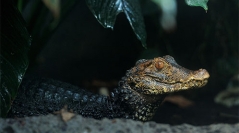

 Comptes Rendus Palevol
23 (12) - Pages 161-170
Comptes Rendus Palevol
23 (12) - Pages 161-170The crocodylian dwarf species (i.e., Osteolaemus sp. and Paleosuchus sp.) that live in the equatorial forests all share the peculiarity to present an osteoderm shield which extends beyond the dorsal area that lies between the skull and the caudal crest symphysis. Here we study both the morphology and the microanatomy of the osteoderms in Paleosuchus palpebrosus (Cuvier, 1807), in order to both assess the distribution of bone ornamentation over the osteoderm shield, and to compare the porosity between the dorsal osteoderms with the non-dorsal osteoderms. Since both the ornamental pit excavation and the bone porosity are relevant proxies to the osteoderm blood vessel content, we mapped the distribution of the vascular network within the osteoderm shield in P. palpebrosus. Our results show that both the bone ornamentation and the bone porosity are significantly more pronounced within the dorsal shield osteoderms. Our results suggest that the dorsal osteoderms may be involved in heat transfer via the superficial blood vessels that are located in the ornamental pits if they are artificially exposed to a basking lamp in captive conditions; it is however unlikely to be the case under the canopy of the equatorial forest since the sun exposure is poor. We therefore hypothesize that the dwarf crocodylian extended osteoderm shield mostly consists of a labile calcium resource that would allow to buffer the diet variations which are related to the various equatorial forest niches (i.e., streams, excavated pools, jungle floors, caves).
Crocodylia, dwarfism, heat transfer, diet, niche